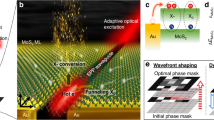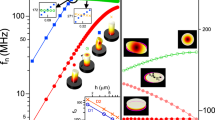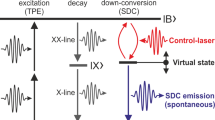Abstract
The quest for an integrated quantum optics platform has motivated the field of semiconductor quantum dot research for two decades. Demonstrations of quantum light sources, single photon switches, transistors and spin–photon interfaces have become very advanced. Yet the fundamental problem that every quantum dot is different prevents integration and scaling beyond a few quantum dots. Here, we address this challenge by patterning strain via local phase transitions to selectively tune individual quantum dots that are embedded in a photonic architecture. The patterning is implemented with in operando laser crystallization of a thin HfO2 film ‘sheath’ on the surface of a GaAs waveguide. Using this approach, we tune InAs quantum dot emission energies over the full inhomogeneous distribution with a step size down to the homogeneous linewidth and a spatial resolution better than 1 µm. Using these capabilities, we tune multiple quantum dots into resonance within the same waveguide and demonstrate a quantum interaction via superradiant emission from three quantum dots.
This is a preview of subscription content, access via your institution
Access options
Access Nature and 54 other Nature Portfolio journals
Get Nature+, our best-value online-access subscription
$29.99 / 30 days
cancel any time
Subscribe to this journal
Receive 12 print issues and online access
$259.00 per year
only $21.58 per issue
Buy this article
- Purchase on Springer Link
- Instant access to full article PDF
Prices may be subject to local taxes which are calculated during checkout




Similar content being viewed by others
Data availability
The data that support the findings of this study are available from the corresponding author upon reasonable request.
Code availability
COMSOL code used to simulate thermal and strain profiles is available from the corresponding author upon request.
References
Warburton, R. J. et al. Optical emission from a charge-tunable quantum ring. Nature 405, 926–929 (2000).
Lodahl, P., Mahmoodian, S. & Stobbe, S. Interfacing single photons and single quantum dots with photonic nanostructures. Rev. Mod. Phys. 87, 347–400 (2015).
Petruzzella, M. et al. Quantum photonic integrated circuits based on tunable dots and tunable cavities. APL Photon. 3, 106103 (2018).
Liu, F. et al. High Purcell factor generation of indistinguishable on-chip single photons. Nat. Nanotechnol. 13, 835–840 (2018).
Kiravittaya, S., Rastelli, A. & Schmidt, O. G. Advanced quantum dot configurations. Rep. Prog. Phys 72, 046502 (2009).
Yakes, M. K. et al. Leveraging crystal anisotropy for deterministic growth of InAs quantum dots with narrow optical linewidths. Nano Lett. 13, 4870 (2013).
Jöns, K. D. et al. Triggered indistinguishable single photons with narrow line widths from site-controlled quantum dots. Nano Lett. 13, 126 (2013).
Yoshie, T. et al. Vacuum Rabi splitting with a single quantum dot in a photonic crystal nanocavity. Nature 432, 200–203 (2004).
Reithmaier, J. P. et al. Strong coupling in a single quantum dot–semiconductor microcavity system. Nature 432, 197–200 (2004).
Senellart, P., Solomon, G. & White, A. High-performance semiconductor quantum-dot single-photon sources. Nature 12, 1026–1039 (2017).
Huber, D. et al. Strain-tunable GaAs quantum dot: a nearly dephasing-free source of entangled photon pairs on demand. Phys. Rev. Lett. 121, 33902 (2018).
Schwartz, I. et al. Deterministic generation of a cluster state of entangled photons. Science 354, 434–437 (2016).
Aharonovich, I., Englund, D. & Toth, M. Solid-state single-photon emitters. Nat. Photon. 10, 631–641 (2016).
Kroutvar, M. et al. Optically programmable electron spin memory using semiconductor quantum dots. Nature 432, 81–84 (2004).
Sun, S., Kim, H., Luo, Z., Solomon, G. S. & Waks, E. A single-photon switch and transistor enabled by a solid-state quantum memory. Science 361, 57–60 (2018).
Javadi, A. et al. Spin–photon interface and spin-controlled photon switching in a nanobeam waveguide. Nat. Nanotechnol. 13, 398–403 (2018).
De Greve, K. et al. Quantum-dot spin–photon entanglement via frequency downconversion to telecom wavelength. Nature 491, 421–425 (2012).
Gao, W. B., Fallahi, P., Togan, E., Miguel-Sanchez, J. & Imamoglu, A. Observation of entanglement between a quantum dot spin and a single photon. Nature 491, 426–430 (2012).
Schaibley, J. R. et al. Demonstration of quantum entanglement between a single electron spin confined to an InAs quantum dot and a photon. Phys. Rev. Lett. 110, 167401 (2013).
Stockill, R. et al. Phase-tuned entangled state generation between distant spin qubits. Phys. Rev. Lett. 119, 10503 (2017).
Delteil, A. et al. Generation of heralded entanglement between distant hole spins. Nat. Phys. 12, 218–223 (2016).
Pagliano, F. et al. Dynamically controlling the emission of single excitons in photonic crystal cavities. Nat. Commun. 5, 5786 (2014).
Kim, J. H., Aghaeimeibodi, S., Richardson, C. J. K., Leavitt, R. P. & Waks, E. Super-radiant emission from quantum dots in a nanophotonic waveguide. Nano Lett. 18, 4734–4740 (2018).
Faraon, A. et al. Local quantum dot tuning on photonic crystal chips. Appl. Phys. Lett. 90, 213110 (2007).
Muller, A., Fang, W., Lawall, J. & Solomon, G. S. Creating polarization-entangled photon pairs from a semiconductor quantum dot using the optical Stark effect. Phys. Rev. Lett. 103, 217402 (2009).
Sweeney, T. M. et al. Cavity-stimulated raman emission from a single quantum dot spin. Nat. Photon. 8, 442–447 (2014).
Fernandez, G., Volz, T., Desbuquois, R., Badolato, A. & Imamoglu, A. Optically tunable spontaneous Raman fluorescence from a single self-assembled InGaAs quantum dot. Phys. Rev. Lett. 103, 087406 (2009).
Yuan, X. et al. Uniaxial stress flips the natural quantization axis of a quantum dot for integrated quantum photonics. Nat. Commun. 9, 3058 (2018).
Ding, F. et al. Tuning the exciton binding energies in single self-assembled InGaAs/GaAs quantum dots by piezoelectric-induced biaxial stress. Phys. Rev. Lett. 104, 67405 (2010).
Kuklewicz, C. E., Malein, R. N. E., Petroff, P. M. & Gerardot, B. D. Electro-elastic tuning of single particles in individual self-assembled quantum dots. Nano Lett. 12, 3761–3765 (2012).
Höfer, B. et al. Independent tuning of excitonic emission energy and decay time in single semiconductor quantum dots. Appl. Phys. Lett. 110, 151102 (2017).
Stepanov, P. et al. Large and uniform optical emission shifts in quantum dots strained along their growth axis. Nano Lett. 16, 3215–3220 (2016).
Bouwes Bavinck, M. et al. Controlling a nanowire quantum dot band gap using a straining dielectric envelope. Nano Lett. 12, 6206–6211 (2012).
Ellis, D. J. P. et al. Control of fine-structure splitting of individual InAs quantum dots by rapid thermal annealing. Appl. Phys. Lett. 90, 2005–2008 (2007).
Nakaoka, T. et al. Tuning of g-factor in self-assembled In(Ga)As quantum dots through strain engineering. Phys. Rev. B 71, 205301 (2005).
Rastelli, A. et al. In situ laser microprocessing of single self-assembled quantum dots and optical microcavities. Appl. Phys. Lett. 90, 73120 (2007).
Fiset-Cyr, A. et al. In-situ tuning of individual position-controlled nanowire quantum dots via laser-induced intermixing. Appl. Phys. Lett. 113, 53105 (2018).
Takahashi, M. et al. Local control of emission energy of semiconductor quantum dots using volume expansion of a phase-change material. Appl. Phys. Lett. 102, 93120 (2013).
Dicke, R. H. Coherence in spontaneous radiation processes. Phys. Rev. 93, 99–110 (1954).
Mcardell, B. W. et al. The super of superradiance. Science 325, 1510–1512 (2009).
Goban, A. et al. Superradiance for atoms trapped along a photonic crystal waveguide. Phys. Rev. Lett. 115, 063601 (2015).
Sipahigil, A. et al. An integrated diamond nanophotonics platform for quantum optical networks. Science 354, 847–850 (2016).
Venkatachalam, D. K., Bradby, J. E., Saleh, M. N., Ruffell, S. & Elliman, R. G. Nanomechanical properties of sputter-deposited HfO2 and HfxSi1 − xO2 thin films. J. Appl. Phys. 110, 43527 (2011).
Hausmann, D. M. & Gordon, R. G. Surface morphology and crystallinity control in the atomic layer deposition (ALD) of hafnium and zirconium oxide thin films. J. Cryst. Growth 249, 251–261 (2003).
Lounis, B., Orrit, M., Koganov, G. A. & Shuker, R. Few emitters in a cavity: from cooperative emission to individualization. New J. Phys. 13, 93020 (2011).
Kambs, B. & Becher, C. Limitations on the indistinguishability of photons from remote solid state sources. New J. Phys. 20, 115003 (2018).
Pursley, B. C., Carter, S. G., Yakes, M. K., Bracker, A. S. & Gammon, D. Picosecond pulse shaping of single photons using quantum dots. Nat. Commun. 9, 115 (2018).
Somaschi, N. et al. Near-optimal single-photon sources in the solid state. Nat. Photon. 10, 340–345 (2016).
Sohn, Y. I. et al. Controlling the coherence of a diamond spin qubit through its strain environment. Nat. Commun. 9, 17–22 (2018).
Lee, K. W. et al. Strain coupling of a mechanical resonator to a single quantum emitter in diamond. Phys. Rev. Appl. 6, 034005 (2016).
Carter, S. G. et al. Sensing flexural motion of a photonic crystal membrane with InGaAs quantum dot. Appl. Phys. Lett. 111, 183101 (2017).
Wuttig, M., Bhaskaran, H. & Taubner, T. Phase-change materials for non-volatile photonic applications. Nat. Photon. 11, 465–476 (2017).
O’Brien, J. L., Furusawa, A. & Vučković, J. Photonic quantum technologies. Nat. Photon. 3, 687–695 (2009).
Vora, P. M. et al. Spin–cavity interactions between a quantum dot molecule and a photonic crystal cavity. Nat. Commun. 6, 7665 (2015).
Löbl, M. C. et al. Narrow optical linewidths and spin pumping on charge-tunable close-to-surface self-assembled quantum dots in an ultrathin diode. Phys. Rev. B 96, 165440 (2017).
Acknowledgements
This work was supported by the US Office of Naval Research, the Defense Threat Reduction Agency (grant no. HDTRA1-15-1-0011), and the OSD Quantum Sciences and Engineering Program. A.C.K. acknowledges the support of the American Society for Engineering Education and US Naval Research Laboratory postdoctoral fellowship program. J.T.M. and B.L. acknowledge the support of the NRC Research Associateship Program at the US Naval Research Laboratory.
Author information
Authors and Affiliations
Contributions
J.Q.G. and A.S.B. conceived of the tuning concept. J.Q.G., A.S.B., S.G.C. and D.G. further developed the tuning concept. J.Q.G. performed the QD energy tuning, spectroscopy and photon correlation measurements. M.Z. and J.Q.G. performed the electron diffraction measurements. M.Z. did the finite-element modelling of the thermal and strain profiles. A.C.K. did HfO2 ALD. A.S.B. and M.Y. grew the QDs with MBE. M.K. and C.K. fabricated the structures and measured SEM. J.T.M. and A.S.B. did AFM measurements and analysis. J.Q.G. and B.L. performed basic sample characterization.
Corresponding author
Ethics declarations
Competing interests
The authors declare no competing interests.
Additional information
Publisher’s note: Springer Nature remains neutral with regard to jurisdictional claims in published maps and institutional affiliations.
Supplementary information
Supplementary Information
Supplementary Information, Supplementary Figs. 1–12, Supplementary references 1–7
Rights and permissions
About this article
Cite this article
Grim, J.Q., Bracker, A.S., Zalalutdinov, M. et al. Scalable in operando strain tuning in nanophotonic waveguides enabling three-quantum-dot superradiance. Nat. Mater. 18, 963–969 (2019). https://doi.org/10.1038/s41563-019-0418-0
Received:
Accepted:
Published:
Issue Date:
DOI: https://doi.org/10.1038/s41563-019-0418-0
This article is cited by
-
InP colloidal quantum dots for visible and near-infrared photonics
Nature Reviews Materials (2023)
-
Quantum interference of identical photons from remote GaAs quantum dots
Nature Nanotechnology (2022)
-
Magnetic tuning of tunnel coupling between InAsP double quantum dots in InP nanowires
Scientific Reports (2022)
-
Nonlinear down-conversion in a single quantum dot
Nature Communications (2022)
-
On-chip generation and dynamic piezo-optomechanical rotation of single photons
Nature Communications (2022)



